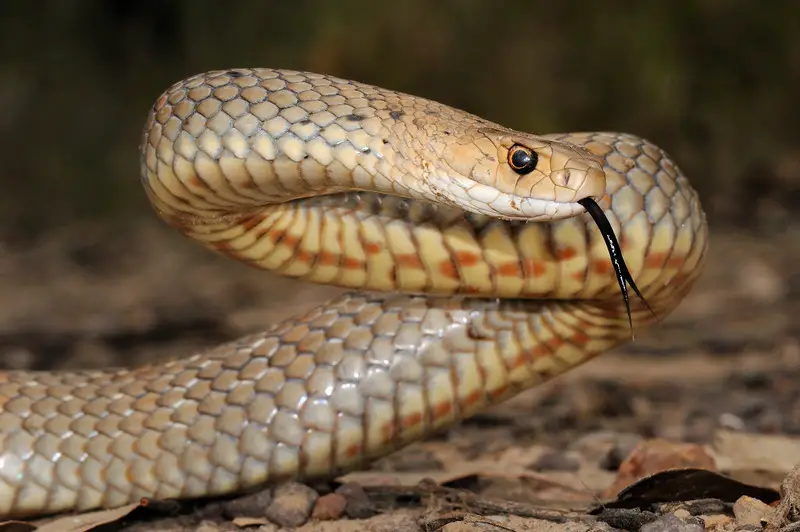The eastern brown snake (Pseudonaja textilis) is one of the deadliest snakes in the world—second only to Belcher’s sea snake. The snake is a native species of Papua New Guinea, Australia, and Indonesia. It was discovered in Papua New Guinea back in 1953 but biologists have yet to understand how he got there.
Eastern Brown Snake Facts
Anatomy
- It is a medium sized snake with a slender body.
- While the eastern brown snake is extremely varied in skin color the uniform brown shade is mainly dominant in nearly all brown snakes.
- There are many different patterns in the form of bands on its skin. The color ranges from orange, yellow, black, silver to grey. Young snakes typically show black head with lighter bands and red markings on the belly.
- Eastern brown snake averages 1.1–1.8 m (3.6–5.9 ft) in total length including tail. The longest recorded brown snake is at 2.4 m (7.9 ft). The physical features of eastern brown snake appear to be the same as those of king brown snake.
Distribution
Eastern brown snakes are thought to occur mainly in eastern Australia—ranging from Cape York Peninsula to the New South Wales. It also inhabits the southeastern South Australia. Some of the isolated population is also found in the Northern Territory. They are widely distributed in Papua New Guinea and Indonesia.

Habitat
- Eastern brown snakes will make homes in a variety of habitats such as savannah woodlands, Eucalypt forests, arid scrublands, heaths of coastal ranges, and inner grasslands
- The snake is absent from wet areas nor does it live in extremely dry habitats.
- They seek shelter in large rocks or under fallen logs as well as in burrows and deep soil cracks.
Behavior
- Eastern brown snake will remain active during the day. It is thought to move extremely fast and is highly aggressive.
- When provoked, they will raise their heads but may avoid confrontation if possible.
Feeding Ecology & Diet
- Eastern brown snakes primarily feed on frogs, bird eggs, house mice and rarely other small snakes.
- They highly active predators and may often search prey with their remarkable eyesight. Eastern brown snakes remain active during the day but they usually avoid hot temperature. Therefore at times they do emerge in early evening or in the later afternoon when the sun goes down.
- The captive brown snakes show cannibalistic behavior. If the prey is too large then probably the snake may grab it before finally swallowing it.
Reproductive Biology
- The peak mating season of eastern brown snakes occur in spring. Males compete with each other for the female counterpart.
- There are 10 – 40 eggs in a single clutch. However on average a female lays up to 15 eggs. The egg laying occurs in early summer and in late spring.
- Eggs hatch in about 1 – 3 months. If the food is abundant then the female will lay many clutches in a single season. The young remain in the eggs for up to 8 hours.
- Neither of the parents looks after the eggs. Young snakes are independent right from birth.
Predators
- Birds of prey
- Feral cats
- Mulga Snake






Leave a Reply